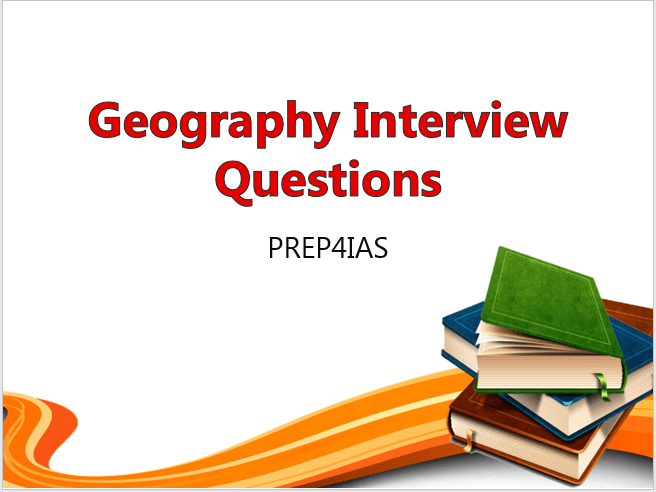In this session, I will take you through 500+ Important Interview Geography Questions asked by UPSC Panel Part - 1. Many times students wanted to know about Geography Questions that frequently gets asked in UPSC Interview. I have brought a Series of Geography Interview Questions that will be covered in multiple parts. This is Part - 1 of Interview Geography Questions that gets frequently asked by UPSC Panel.

Geography Questions
Also Read: 50 Best Questions on Rivers of India
1.What are different types of Winds ?
Ans. Following are the three broad types of winds:-
a) Permanent winds – The trade winds, westerlies and easterlies are the permanent winds. These blow constantly throughout the year in a particular direction.
b) Seasonal winds – These winds change their direction in different seasons. For e.g. monsoons in India.
c) Local winds – These blow only during a particular period of the day or year in a small area. For example, land and sea breeze; Loo in India.
2. What is strong, cold and usually dry regional wind called in France ?
Ans. Mistral
3. What is the reason for complete reversal of Ocean Currents in Indian Ocean ?
Ans. It is due to monsoonal effect and seasonal changes of winds which induces change in ocean currents flow direction accordingly.
4. Where can you find the location of most of the deserts ?
Ans. Between 15-30 degree N-S Latitude
5. Which temperate grassland are usually found in Europe ?
Ans. Pustaz
6. What is the usual gradient of slope between Continental Shelf and Ocean Basin ?
Ans. 2-5 degree
7. Which is the largest Continental Shelf in the world ?
Ans. The Siberian shelf in the Arctic Ocean stretches upto 1500 KM
8. What are the primary factors responsible for formation of Soil ?
Ans. Five factors are mainly responsible:-
a)Parent Material
b)Topography
c)Climate
d)Biological Activity
e)Time
9. What are the passive soil forming factors ?
Ans. Time, Parent Material and Topography
10. What are the two different types of Temperature Inversions ?
Ans. Two types:-
a)Permanent
b)Surface
11. Which are the water bodies passes through Prime Meridian ?
Ans. Arctic Ocean, Norwegian Sea, Greenland Sea, Mediterranean Sea, Atlantic Ocean and Southern Ocean.
12.Which strait separates Papua Guinea from Australia ?
Ans.Torres Strait
13. Which Strait separates Tasmania from the Australian mainland ?
Ans. Bass Strait
14. Which Strait separates Mexico from Cuba ?
Ans. The Yucatán Channel or Straits of Yucatán
15. At what angles from Epicentre both P-wave and S-wave will not be available ?
Ans. Any places lies between 105 degree and 145 degree from epicentre will not receive P and S waves.
16. At what angle from epicentre P-wave can be detected by Seismograph ?
Ans. It will be detected in 2 different Zones:-
a)Between 0 to 105 degree angle from epicentre
b)Beyond 105 degree angle from epicentre
17. After what angle from epicentre S-wave cannot be detected by Seismograph ?
Ans. Beyond 105 degree
18. What is the density of Earth Crust ?
Ans. Around 2.83 gm/cm3
19. What is the density of Earth Mantle Layer ?
And. Around 3.4 gm/cm3
20. What is the density of material at the mantle core boundary ?
Ans. Around 5g/cm3
21. What is the density of material at the centre of earth ?
Ans. Around 13g/cm3
22. Where is Senkaku Islands located ?
Ans. East China Sea
23. Who had proposed the theory of "Sea Floor Spreading" ?
Ans. Hess in 1961
24. Who had proposed the Continental Drift Theory ?
Ans. Alfred Wegener
25. Where is Lake Titicaca located ?
Ans. Titicaca is a large, deep lake in the Andes on the border of Bolivia and Peru, often called the "highest navigable lake" in the world.
26. Which is oldest and deepest Lake in Africa ?
Ans. Lake Tanganyika
27. What is the main reason of Shrinkage of Aral Sea ?
Ans. Diversion of River Amu Darya in 20th and 21st Century for Agriculture Purpose.
28. Where is Scarborough Shoal located ?
Ans. Scarborough Shoal, also known as Huangyan Dao, Bajo de Masinloc, and Democracy Reef are two rocks in a shoal located between the Macclesfield Bank and Luzon island in the South China Sea.
29. What is Nutrient Pollution ?
Ans. Nutrient pollution is the process where too many nutrients, mainly nitrogen and phosphorus, are added to bodies of water and can act like fertilizer, causing excessive growth of algae.
30. Which crop is known as Monsoon Crop ?
Ans. Kharif Crop
I hope you liked this session of Geography Questions Part - 1. Please provide your feedback on Comment Box and stay tuned for next part of Interview Geography Questions.
Also Read: Indian Geography by Majid Hussain
